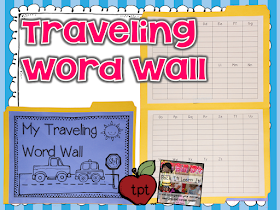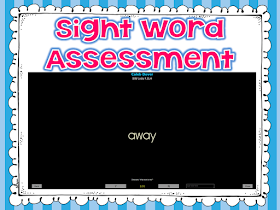Ever ask yourself any of those questions? Those were some of the questions asked during a recent webinar "The Wonderful and Wacky World of Words".
Let's start off by looking at a word wall.
In today's kindergarten classroom a word wall is a staple just like shapes and abcs. Most teachers are told to "have" a word wall with little guidance as to how to form it, what words to put on it, and what to do with it. Across the country, even within states and districts, the guidelines are not consistent. Some require kids to know 20 words, some require over 100! It really doesn't matter how many words you are putting on the word wall, it isn't an indicator of how many words your kids know. Here are some of the guidelines I use for my word wall:
- I usually put up 3-5 words a week, starting after about 4 weeks of school. Some of the "short" or "holiday" weeks, I might not add any new. Children do not need to know the alphabet to learn the sight words. You can read more about that in this post.
- The words I use are a combination of resources. I started with our county list of words, as indicated on our assessment. Then, I looked at Fry's list of words. These are the most commonly occurring words in text. Last, I looked at our leveled readers to be sure the sight words from levels A-D were included.
- The true goal is for kids to be able to USE the word wall. Often kids ask, "Which word is 'the'?" Then, you have to decide your plan of action. Do you get up and go show them? Do you send them with a friend that knows? Or do you want them to be self sufficient and be able to locate the word with a little direction?
- I chose the later. So here is what I did. I color coded my sight words so that under each letter every word would be on a different color of paper. That way, when kids ask which word is 'the', I could tell them it was the RED word under 't'. You can snag the list of words that will make this super simple at the bottom of this post.
- I start with the words on a "Parking Lot". Each Monday, after introducing the new words, we do NOT put them on the word wall. They would get lost. Instead, I put them on the parking lot. This reminds me of the words I want to focus on during games, charting, etc.
- You can snag a copy of this traveling word wall at the end of this post. The PDF is editable so that you can generate your own list of words.
- Each child is developing their own traveling word wall. The purpose of this word wall is to teach children how a word wall is organized. The simple act of writing the words on the chart, does not ensure that children know the word! Some teachers have asked if the small space is a problem for the kids. Most sight words are short, at least at the beginning of the year. They can easily fit a 2-3 letter word in the space. However, if a child has a developmental or cognitive disability that prohibits him from doing so, accommodate! You could write it with a highlighter and let them trace. You could give them the word already written and let them glue it in the right space. You will also want to visit the traveling word wall during writer's workshop to show children how to USE the word wall. The act of making the word wall teaches children how it is organized, but a mini lesson in writer's workshop can show them how to use it! The traveling word wall is part of my Pack It! Learn It! unit.
- Shortly after the beginning of the year, I assess each child on their sight words. I simply have them read me a list of the words, indicating which ones they know and which ones they don't know.
- ESGI provides a simple way to accomplish this task, easily and quickly. If you haven't tried ESGI you can, for FREE! Simply go to ESGI to register for your free trail. Be sure and use the code ADSIT when registering to save $40 if you decide to purchase later!
- Once I know the sight words each child knows, I want to develop an individual word ring for each child. The child should know 70% of the words on the ring, and 30% should be unkown words. If you child doesn't know enough words to do that, use colors, numerals, letters, etc to make up the 70%. Slowly weed those out as he learns words.
- Each child now has a ring of the words THEY know. Each day, as the kids come in, they find their word wall hanging on the side of a cabinet and take it to their morning work space. I walk around, along with several parent volunteers, and let the kids read the words to me. Add to the rings when the children master one of the unknown words, always keeping about 70% known and 30% unknown. To keep it simple, once my kids have 10 words on their ring, 7 they know and 3 they don't they are working at a 70-30 ration. At this point, I try to keep 3 unknown words on the ring. The ring works great because you can determine the speed.
- When learning sight words, kids are first accurate. This means they get the word right. But, then they become automatic--they have automaticity. This means that they know the words without thinking about it. This is when we see children able to transfer the learning the word in isolation to reading it in text.
- Do not let kids sound out words, or think about it! If kids don't know the word, tell them and move on. Remember the ring is mostly words they knew on the assessment.
- Our assessment tests both their accuracy rate and their automaticity rate. To do this, set a timer for one minute. Show the child the list. Have them read the list. No need to stress them about the timer! When the timer goes off, draw a line on the list. Let the child keep reading for the accuracy rate.
- Each district, school, or state determines how many words a kid should know. Just for a point of reference, I put up over 100 words. But, for our assessment, the children have to read 100 words. This means that not all children know the same words. Also, we assess for accuracy. The children need to read 30 words in a minute. Do all my kids reach this goal. To be honest, no. But I would say that over 80% do!
The Key to Sight Word Success
- The key is slow and steady. Add words each and every week. Don't try to add 20 words in one day because you are behind.
- Put the words on a Parking Lot on Monday. Use the words all week in your games, charting and other activities.
- Have children develop a traveling word wall so that they can learn how a word wall works and how it is formed.
- Make an individual word ring for each child. Let the children read their rings to you daily. Slowly adding new words.
If you have more questions about learning sight words, leave your questions in the comments below! Be sure and stay tuned for more answered questions from the webinar. I have blog post planned for Games and Activities to Teach Sight Words, Learning Vocabulary, Weekly Word Work Schedule and Word Families & CVC words. That means there will be 4 more posts where I will answer your questions!










My grandson is 5years and 8months old. How can I go about teaching him sight words? I've tried the 3-5 a week. It just seems so hard for him.
ReplyDeleteDo you have a file for your word rings? I am curious about size, etc. Do you end up will all 100 words on the ring?
ReplyDeleteThanks!
Yes, they are index card boxes. I got them at Office Depot. They are really long but standard width. Some kids have all 100+ words. Some kids have less....
ReplyDeleteThis comment has been removed by a blog administrator.
ReplyDeleteI love your word wall! Where can I purchase it? Can't find it in your TPT store. Thanks!
ReplyDelete